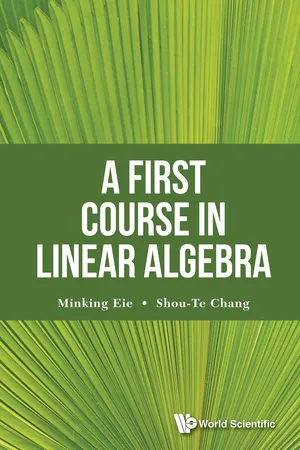
- 384 pages
- English
- ePUB (mobile friendly)
- Available on iOS & Android
A First Course in Linear Algebra
About this book
A First Course in Linear Algebra is written by two experts from algebra who have more than 20 years of experience in algebra, linear algebra and number theory. It prepares students with no background in Linear Algebra. Students, after mastering the materials in this textbook, can already understand any Linear Algebra used in more advanced books and research papers in Mathematics or in other scientific disciplines.
This book provides a solid foundation for the theory dealing with finite dimensional vector spaces. It explains in details the relation between linear transformations and matrices. One may thus use different viewpoints to manipulate a matrix instead of a one-sided approach. Although most of the examples are for real and complex matrices, a vector space over a general field is briefly discussed. Several optional sections are devoted to applications to demonstrate the power of Linear Algebra.
Contents:
- Preface
- Vector Spaces
- Bases and Dimension
- Linear Transformations and Matrices
- Elementary Matrix Operations
- Diagonalization
- Canonical Forms
- Inner Product Spaces
Readership: Undergraduates who are interested in learning linear algebra and its applications.
Frequently asked questions
- Essential is ideal for learners and professionals who enjoy exploring a wide range of subjects. Access the Essential Library with 800,000+ trusted titles and best-sellers across business, personal growth, and the humanities. Includes unlimited reading time and Standard Read Aloud voice.
- Complete: Perfect for advanced learners and researchers needing full, unrestricted access. Unlock 1.4M+ books across hundreds of subjects, including academic and specialized titles. The Complete Plan also includes advanced features like Premium Read Aloud and Research Assistant.
Please note we cannot support devices running on iOS 13 and Android 7 or earlier. Learn more about using the app.
Information
CHAPTER 1
Vector Spaces
1.1 A few words on sets and logics
Table of contents
- Cover page
- Title page
- Copyright
- Preface
- Notation
- About the Authors
- Contents
- 1 Vector Spaces
- 2 Bases and Dimension
- 3 Linear Transformations and Matrices
- 4 Elementary Matrix Operations
- 5 Diagonalization
- 6 Canonical Forms
- 7 Inner Product Spaces
- Index